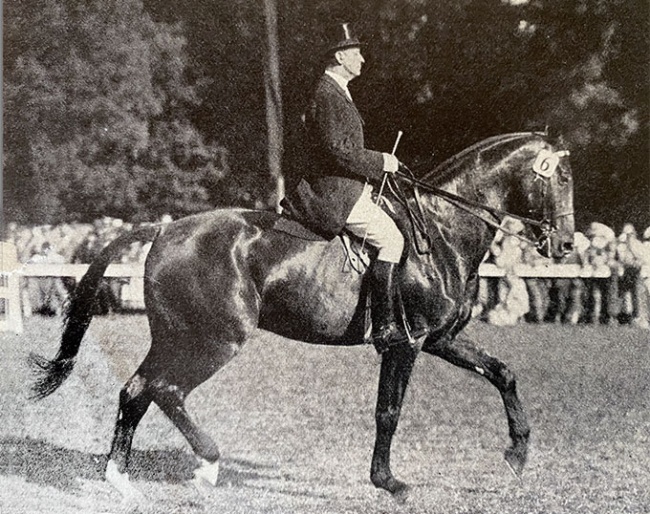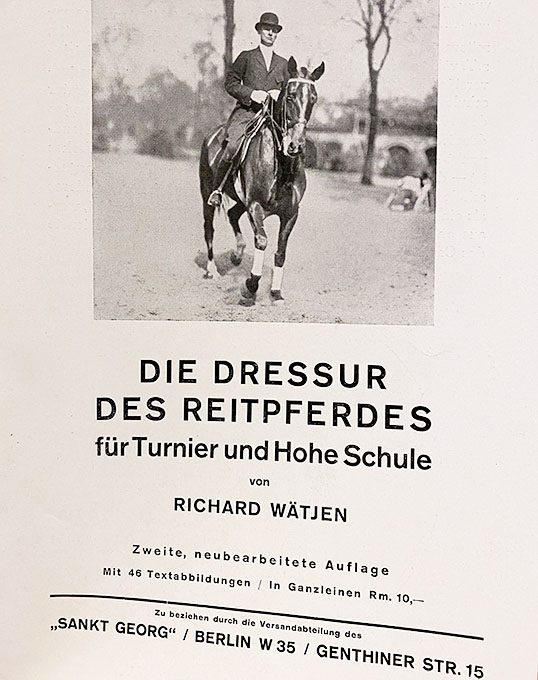
This article is a continuation of Richard Wätjen: Forgotten Hero of Equestrian Sport and Classical Dressage
In this excerpt from "Still Horse Crazy After All These Years: If It Didn’t Happen This Way, It Should Have," (2021, Trafalgar Square Books) the late Olympian and tale-teller Jim Wofford shares a formative experience with an equestrian coach - Richard Wätjen - that told him all he needed to know about what it takes to be a good rider.
When I first came to Gladstone in 1965, Richard Wätjen was coaching the dressage team, and I audited his lessons whenever possible. Wätjen, German by birth, was classically trained at the Spanish Riding School in Vienna after WWI and had become a coach after WWII. Tall and portly, he was a legend in the dressage world, and must have been a tough old buzzard as well. In the winter of 1966–67, Nautical Hall, the indoor riding arena at Gladstone, was one of the coldest places on Earth, but no matter how cold it was, Wätjen taught in slacks and street shoes, wearing a dark green Loden greatcoat. He was not an inspiring instructor, and his comments were brief and pungent. “More,” was one of his favorites, along with “Again,” and “No.” I never knew if teaching in a second language was a problem for him, or if it was just his style, and I was too intimidated to ask.

in the early 1930s
(Photo © St; Georg Archive)
Once Wätjen had finished his work with the Team horses, he taught occasional outside lessons for dressage riders. A woman showed up for one lesson with a very fancy, recently imported horse reputed to have set her back a princely sum. (Given the fur coat and diamonds she was sporting, I donʼt think she noticed the cost a bit.) It was obvious after she careened around the ring for a few minutes that she couldnʼt get this creature even close to being on the bit.
Then magic happened. Telling this unfortunate lady to ride in and “get down,” Wätjen turned toward the corner of the arena where Rick Eckhart and I were cowering. Pointing at us, he said, “Boys. Come here.”
Next thing we knew, we were holding the horse while, in street shoes and gabardine slacks, Wätjen laboriously stepped aboard. He would have been in his late seventies by this time, and his beer belly indicated he wasnʼt much for exercise. I knew he had been a fabulous rider in his day—a long time ago. He walked off gathering his reins, then moved into working trot. By now the horse was starting to settle into the contact and produced a few transitions from working trot to collected trot, followed by extended trot across each diagonal. This happened with no discernable aids, as Wätjen sat bolt upright in the saddle. Some canter work followed, including several flying changes remarkable for their straightness and fluidity.

which experienced several reprints through
several decades and was also published
in English later on
Gesturing with his hand toward her shoulder, Wätjen said, “Vell, you must sit mit a straight line from shoulder, to hip, to heel.” She replied eagerly, “Yes, yes, I am doing that.” Wätjen continued, “... und zen you are riding mit a straight line from elbow to horseʼs mouth.” The lady pounced on this statement with glee, “Yes, yes. I have been doing this.” “Goot!” said Wätjen. “Now you must practice for 30 years.” I started to crack up at what I thought was a masterful put-down, but I happened to take a look at Wätjenʼs face. He wasnʼt putting her down, or kidding. He was serious.
Richard Wätjen - Part III: Interview with Donnan Sharp (coming tomorrow)
Order Jimmy Wofford's book "Still Horse Crazy After All These Years: If It Didn’t Happen This Way, It Should Have," (2021, Trafalgar Square Books)
Related Links
The Essential Guide to the Piaffe - Part II: Taking the Horse’s Individual Conformation into Account
From Flying Past to Flying Change - Part III: The Thoroughbred from the Post-War Times into the 1960s
Noseband Special: Part I: The History of the Noseband
The Double Bridle: An Instrument of Understanding